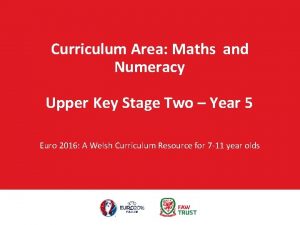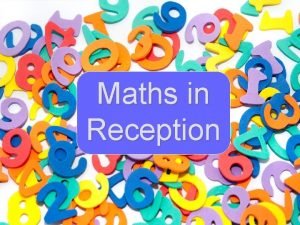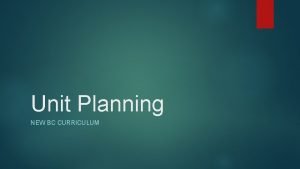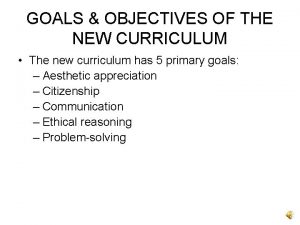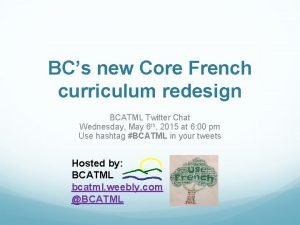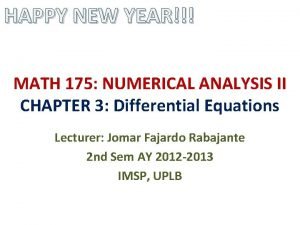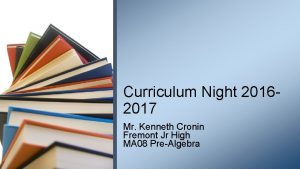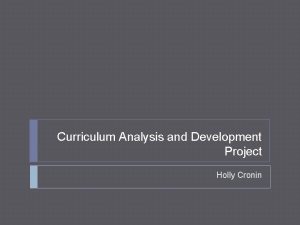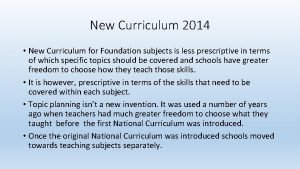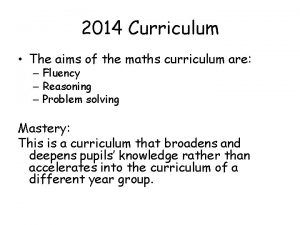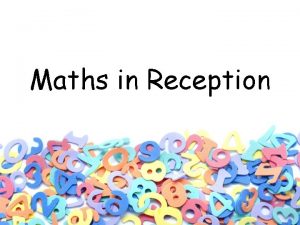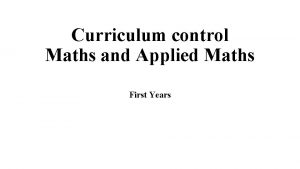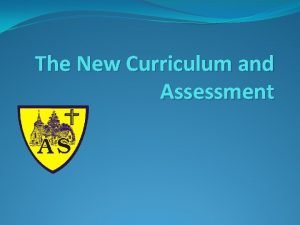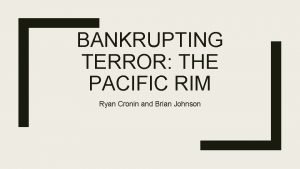New Maths Curriculum 2014 Jo Cronin Freelance Maths




































- Slides: 36

New Maths Curriculum 2014 Jo Cronin Freelance Maths Adviser

Mental Mind Gym coming …. 30 Second Challenge - INTERMEDIATE

3/8 1/5 64 of ÷ 4 +7 x 5 of this x 13 + 5 ÷ 6 x 2 Answer ?

Are you a Maths Fan or Maths Phobic?

The 2014 national curriculum for mathematics has been designed to raise standards in maths, with the aim that the large majority of pupils will achieve mastery of the subject. “By raising standards in basics such as reading, grammar, fractions and basic scientific concepts, children will be equipped to do more advanced work once they start secondary school. ”

Broken down into: • Number – – Number and place value Addition and subtraction Multiplication and division Fractions, decimals and percentages • Measures – Measurement • Geometry – Properties of shape – Position and direction • Statistics


Roman Numerals • What do you think about the teaching of Roman numerals?

Developing Fluency • Pupils become fluent in the fundamentals of mathematics, including through varied and frequent practice with increasingly complex problems over time, so that pupils develop conceptual understanding and the ability to recall and apply knowledge rapidly and accurately.

10 x x 3 x 7 x 2 Learning Times Tables How did you learn yours? 4 x 8 x x 6 5 x x 1

Last one! • • • 4 X 5? 8 X 6? 6 X 7? 7 X 8? 12 X 9?

How to help at home • When your child has begun to learn a table, practise the table for five minutes each day with them. • It is important to say the whole table, not just the answers, again and again! • Break down each table into manageable chunks. For example, ask them 1 x 6, 2 x 6 and 5 x 6 until they know the answers. Then add the next one. • Work on pairs of tables, for example if your child is learning the two times table they can use their doubling facts to calculate the four times tables. • Test your child by firing questions at them, out of order reminding them that they can use facts that they are confident with to work out trickier ones. For example if they know 4 x 6=24 just double to find 8 x 6. • Keep checking that they still know the facts they have learnt and revisit previously learnt facts. • Use a range of vocabulary—times, multiply, lots of, sets of. . .

21 Facts to Learn 1 2 3 4 5 1× 1=1 1× 2=2 1× 3=3 1× 4=4 1× 5=5 1× 6=6 1× 7=7 1× 8=8 1× 9=9 2× 2=4 2× 3=6 2× 4=8 2× 5=10 2× 6=12 2× 7=14 2× 8=16 2× 9=18 3× 3=9 3× 4=12 3× 5=15 3× 6=18 3× 7=21 3× 8=24 3× 9=27 4× 4=16 4× 5=20 4× 6=24 4× 7=28 4× 8=32 4× 9=36 5× 5=25 5× 6=30 5× 7=35 5× 8=40 5× 9=45

6 7 8 9 6× 6=36 6× 7=42 6× 8=48 6× 9=54 7× 7=49 7× 8=56 7× 9=63 8× 8=64 8× 9=72 9× 9=81

Top Maths Apps – Times Tables • DK 10 Mins a Day • Squeebles • Times Table Clock • Early Birds – Times Tables Training

Mathematical reasoning • Focused mathematics talk should remain central to your mathematics lessons. • Pupils reason mathematically by following a line of enquiry, conjecturing relationships and generalisations, and developing an argument, justification or proof using mathematical language.

Odd one out • Which is the odd one out? Why? 6, 15, 28, 36, 66

Problem solving • Pupils can solve problems by applying their mathematics to a variety of routine and non-routine problems with increasing sophistication, including breaking down problems into a series of simpler steps and persevering in seeking solutions. • This could mean starting rather than ending, a topic with a problem, and whether problems provide a suitable context for learning, developing and securing new concepts.

Ben spent 2⁄5 of his money on a CD. The CD cost £ 10. How much money did he have at first? ’

Ready to progress • The expectation is that the majority of pupils will move through the programmes of study at broadly the same pace. When to progress should always be based on the security of pupils’ understanding and their readiness to progress to the next stage.

• Pupils who grasp concepts rapidly should be challenged through rich and sophisticated problems before any acceleration through new content.


• Those pupils who are not sufficiently fluent with earlier material should consolidate their understanding, including through additional practice, before moving on.

How you can support your child at home? v. Look for and talk about numbers in the environment v. Number bonds for 10, 20, 100 v. Times tables v. Play games v. Shopping and giving change. v. Cooking v. Telling the time and reading timetables 24

Money, money • Estimate – at the shops ask your child to estimate how much 3 or 4 items will come to. • At the shops - if you're buying a couple of items in a shop, ask them to guess how much they will cost. • Give them small amounts of pocket money e. g 50 p - what can they buy? If they want to save for something, how long with it take them? • Talk about the items you buy - which are more expensive, which are cheaper? Which are heavier, which are lighter? • Explore quantities by asking them to think about how many different ways they can make 50 p. How many 10 p coins do you need to make £ 1? • When you buy something, get your child to hand over the money. Check the change with them afterwards.

www. aramazu. com

Play Games • Playing number games, including board games like Snakes and Ladders, has been proven by research to increase children’s understanding of relative number size as well as counting.

i. Pad • Doodle Critter Math: Numbers 7 mini games • Little Digits • Number Monsters • Bugs and Numbers

i. Pad • Andrew Brodie – Mental Maths Y 1 -6 • Maths Splat • Operation Maths • Squeebles – Addition and Subtraction

Websites • • www. nrich. maths. org www. ictgames. co. uk www. topmarks. co. uk www. conkermaths. org www. ttrockstars. com www. sumdog. com www. mangahigh. com

Place value with a calculator 234 • • Change the 4 into a 9 Change the 2 into a 7 Explain what you did Take 40 and add 9 or add 100 take 200 away and add 700 or add 50

Add Snap • Deal out all of the cards. • Take it in turns to put a card down and then add your card total to the last card total. • If the amount adds up to 10 you take the pile! • The winner is the person who finishes with all of the cards. Variation +/- 1 snap

Target 10 • Players start with 0. • They take turns to throw the dice, choose to add or subtract the number. • First to make exactly 10 wins.

Fishy fingers • 2 children face each other and at the same time hold up some fingers on one hand. • The first player to say the total of the fingers shown scores a point. First to 10 points wins.

Tic Tac Toe 15 • 1 player uses 1, 3, 5, 7, 9 • The other player uses 0, 2, 4, 6, 8. • The players take it in turns to place a number (they can only use it once) in the noughts and crosses grid. • The first player to complete a line which adds to 15 wins.

Developing Recall Number Facts www. conkermaths. org
 Rédacteur freelance vaucresson
Rédacteur freelance vaucresson Ryan cronin comptroller
Ryan cronin comptroller Mrs cronin
Mrs cronin Fordham summer session
Fordham summer session Jim cronin united healthcare
Jim cronin united healthcare Reicher and cronin
Reicher and cronin Cronin effect
Cronin effect National core curriculum
National core curriculum Upper key stage 2 maths curriculum
Upper key stage 2 maths curriculum Reception maths curriculum
Reception maths curriculum Nzmaths rich tasks
Nzmaths rich tasks Vic curriculum eal continuum
Vic curriculum eal continuum Chemistry new curriculum
Chemistry new curriculum Victorian curriculum eal
Victorian curriculum eal Bced new curriculum
Bced new curriculum New secondary curriculum
New secondary curriculum Objectives of the new curriculum
Objectives of the new curriculum Bcs new curriculum
Bcs new curriculum Equation of happy new year
Equation of happy new year Punctuating split speech
Punctuating split speech New york pennsylvania new jersey delaware
New york pennsylvania new jersey delaware Fresh oil new wine
Fresh oil new wine New hartford cinema
New hartford cinema Strengths of articles of confederation
Strengths of articles of confederation New-old approach to creating new ventures
New-old approach to creating new ventures Kotler e keller
Kotler e keller New years old is new again
New years old is new again New classical macroeconomics
New classical macroeconomics Chapter 16 toward a new heaven and a new earth
Chapter 16 toward a new heaven and a new earth Neil thisse is a loyalist answers
Neil thisse is a loyalist answers New classical and new keynesian macroeconomics
New classical and new keynesian macroeconomics Roosevelt vs taft venn diagram
Roosevelt vs taft venn diagram Teacher twins 2014
Teacher twins 2014 Who traditional medicine strategy 2014-2023
Who traditional medicine strategy 2014-2023 Teacher twins@2014
Teacher twins@2014 Board regulation 1 series of 2014
Board regulation 1 series of 2014 Point of common coupling (pcc)
Point of common coupling (pcc)








